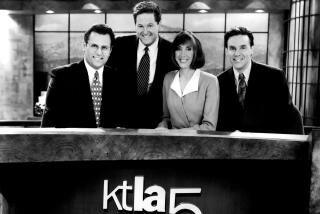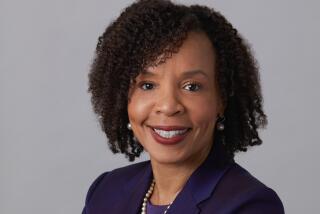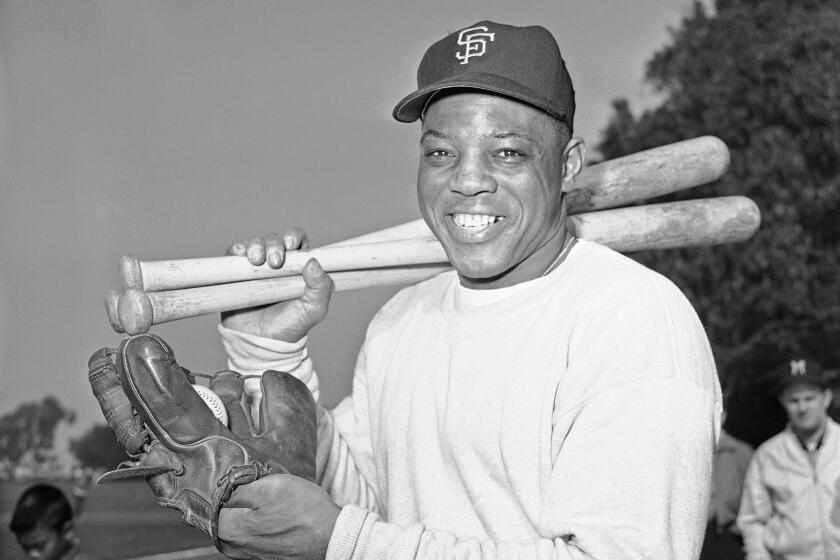The Good Times of Larry Elder
How fortunes can turn. Just 14 months ago, Larry Elder was languishing on KABC-AM (790), his afternoon-drive show cut in half, with him drawing the less desirable 3 to 5 p.m. slot.
The following month, Elder got a new boss when Bill Sommers was named president and general manager of the Disney-owned station. In February, making his first on-air changes, Sommers restored Elder to the full 3 to 7 p.m. position and fired Ed Tyll, who had replaced Elder in the more listener-intensive portion.
Elder--a self-described “libertarian” with a “fiscal conservative and social liberal” outlook--began to flourish. KABC immediately negotiated a five-minute simulcast on a KCAL-TV news show, starting at 3:45 p.m., giving him visibility in as many as 180,000 Southland homes a day.
By last October, Elder had topped the talk competition--John Kobylt and Ken Chiampou on KFI-AM (640) and Tom Leykis on KLSX-FM (97.1)--in overall listenership in two Arbitron ratings periods in a row, encompassing six months. For the previous three months, he shared the top slot with Leykis among 25- to 54-year-olds, whom advertisers target, and led among KABC’s target 35 to 54 demographic with a substantial 4.5% of the audience, improving his own numbers by 45%.
So rather ceremoniously on Dec. 31, KABC announced that it had signed a new four-year contract with Elder. At the same time, Elder got the green light to go national, with Disney’s ABC Radio Network having the first syndication option.
Now a simple how-are-you by phone with Elder evokes a confident, “Excellent.” While neither KABC nor Elder will discuss financial arrangements, it’s presumed that the new contract is considerably better, since the old pact wouldn’t have been up until August. “It shows a commitment of theirs to me and me to them,” Elder notes, “but we began talking about that as soon as Bill Sommers became general manager.” (The timing of his renegotiation proved advantageous: Ratings released on Tuesday showed that Elder lost ground during the final three months of 1998 and now trails KFI.)
As for what the addition of former morning-drive colleague Ken Minyard and his son Rick on KRLA-AM (1110) will mean for the afternoon ratings race, Elder says easily: “I haven’t the slightest idea. But I have a lot of respect for Ken Minyard. He’s a very talented broadcaster.”
Meanwhile, Elder acknowledges that his show has changed somewhat. “I’ve gotten a little more relaxed. And the show is broader. People did say the show had focused on race too often. I never really shared that view, but we do a lot of lighter topics--stuff on television, on media, on popular cul-ture. . . . And I probably am less likely to jump on someone than I was maybe three years ago.”
The politics now has a comedic touch. Elder has begun airing sketches with KABC production director Howard Hoffman, who used to be paired with Stephanie Miller on a morning show in New York. After President Clinton’s testimony before Ken Starr’s federal grand jury last August, Elder wrote a sketch, drawn from his syndicated newspaper column, in which George Washington is testifying on the matter of chopping down the cherry tree.
Prosecutor: But you now admit an “inappropriate” act against that tree. Yet you deny having committed perjury.
Washington: Well, that depends on what the definition of “is” is. When asked the question, I responded in the present tense. Now had the question been “Had there ever been an inappropriate action taken toward that tree?,” that would have been different.
Q: Did you or did you not chop down that cherry tree?
A: Define “tree.”
“The show is driven by the front pages but also by my own interests,” Elder says. “I guess I put a little more of my personality into the show than before.”
The 46-year-old host has even begun talking about his two-year marriage to a longtime friend, a physician, which ended in divorce in 1994. She wanted children; he didn’t.
Although an advertising boycott advocated by a South-Central group called Talking Drum against his show is long since over--the group tagged the African American Elder as anti-black, which he countered was itself “racism”--it gave Elder prime-time exposure on “60 Minutes” in 1997, and draped him with 1st Amendment armor.
”
Now Elder has segued to appearances on CNN and CNBC, Tom Snyder and Chris Rock. He’ll be on with Roseanne and he’s writing a book, tentatively titled “Ten Things You Can’t Say in America.” Among them: “The health care crisis is a lie. The glass ceiling is a crock. Blacks are more racist than whites. White condescension is as bad as black racism. The welfare state is helping us to death.”
And Tyll? He now airs from 10 p.m. to 1 a.m. on CBS-owned KLSX.
Station Reidentification: The first time someone handed Humberto Luna a microphone, he was a youngster standing in his parents’ shoe store in Zacatecas, Mexico, and his job was to broadcast weekly specials over loudspeakers perched on the roof.
Even then, the news and information format bored him. So when KTNQ-AM (1020) switched from a regional Mexican music format to talk radio a few years ago, it was only a matter of time before Luna, the dean of Southern California’s Spanish-language deejays, jumped ship. That time came last month, when Luna walked out of the final eight months of his contract with Heftel Broadcasting and emerged across town as the morning personality at KLAX-FM (97.9).
“I’m very happy because I wanted a show with music, and this station” gave me one, he said. “I wanted this change. I didn’t feel comfortable in talk radio. I couldn’t do what I wanted, which is play music.”
Luna’s new show is the same one he perfected during 20 years at KTNQ--mixing music, skits and a lot of humor. Luna even brought his on-air foils--the Lunaticos, or lunatics--with him from KTNQ and pledged to draw listeners away from Heftel stations KLVE-FM (107.5) and KSCA-FM (101.9), the two top-rated stations in the market.
“I know radio and I know what people want, especially the Mexicans,” Luna says. “It won’t happen overnight, but I want to compete with both.”
Richard Heftel, president and general manager of KTNQ as well as sister stations KLVE and KSCA, has picked up the gauntlet, went to court to seek a temporary restraining order that would keep Luna off the air. That request was denied Tuesday but further legal action is being contemplated.
In the meantime, Luna, 50, is looking ahead, not behind.
“It’s a new era for me,” he says. “It feels like my first day on the radio.”
Even so, he couldn’t resist taking a few jabs at his old bosses. During his first show on KLAX, he pretended to take a call from KTNQ program director Amalia Gonzalez, begging him to come back.
“It wasn’t the same as before. It didn’t feel right. That’s why I left the company,” Luna says. “More than anything else, it was the programming. But they didn’t treat us like before, like a family.”
*
Discrimination Study: The findings of a four-month government study that showed minority-owned or minority-targeted radio stations are discriminated against by advertisers came as no surprise to most Spanish-language broadcasters in Southern California, who have complained for years about their inability to demand ad rates equal to comparable general-market stations.
But few expect the Federal Communications Commission report, released Wednesday, to change the situation.
“I think that the perceived value of my audience is not the same as the perceived value of the general-market audience,” says Andy Mars, general manager of four Spanish-language stations and president of the Southern California Broadcasters Assn. “I don’t hang my hat on FCC guidelines. I think it’s my responsibility to point out the importance of my audience.”
The FCC report found that 91% of the minority-owned radio stations that participated in the study indicated they had encountered “dictates” by advertisers to not buy ads on their stations. In a different survey of 3,745 stations, the report found that advertisers on average paid minority-owned radio stations targeting a minority audience 29% less per listener than non-minority-owned stations targeting a general audience.
The report didn’t pin down the reasons. Many factors, however, could be responsible, including audience demographics, ratings or whether the station is owned by a company operating many radio stations, the report acknowledged.
In Southern California, where Latino spending power is estimated at $57 billion, Spanish stations held the top three spots in the most recent Arbitron rankings of listener preference. Yet the top Spanish outlet in terms of ad revenue--KLVE-FM (107.5)--ranked 10th in the same market through the first seven months of 1998.
Mars placed part of the blame on Spanish-language broadcasters. He says they need to be tougher on advertisers, a tactic TV station KMEX-TV, the local Univision affiliate, used with great success a few years ago.
“They argued that their 10 share of the audience is the same as a 10 share on ABC or any general-market station,” he said. At first advertisers balked, but when KMEX refused to budge, the advertisers eventually came back and agreed to the higher ad rates.
“A major education process has to take place,” adds Jerry Symon, general sales manager for three Spanish-language stations, including KLVE. “We’re so underpriced it’s ridiculous. We should definitely be getting more parity.
“There’ve been times when we’ve demanded it and didn’t get it. There’s not a black and white answer.”



